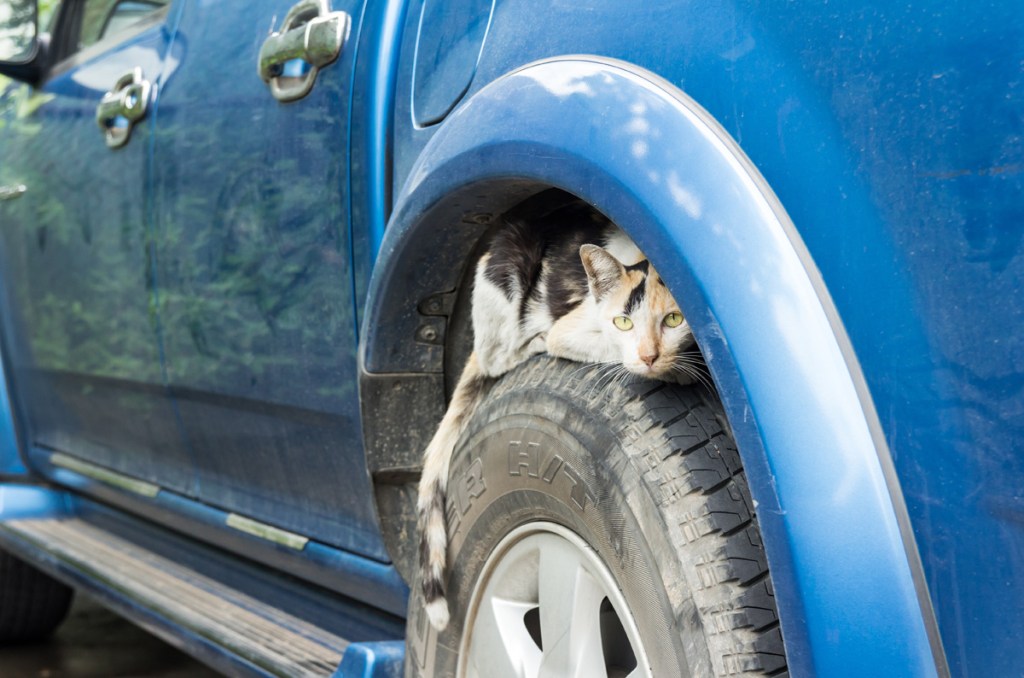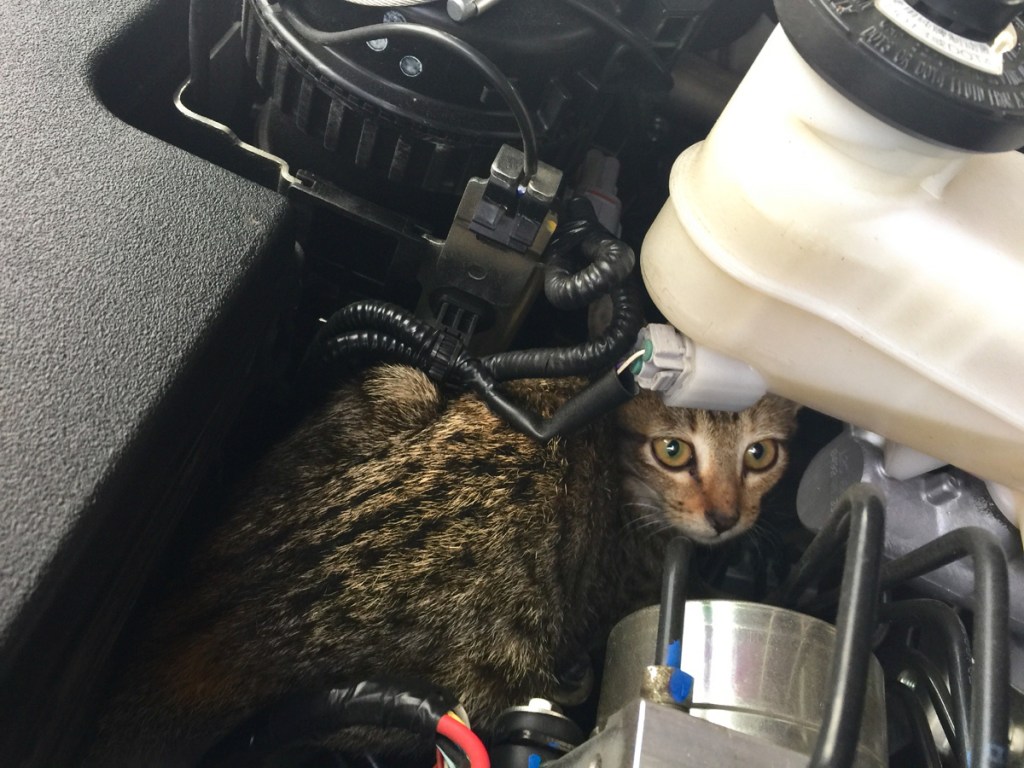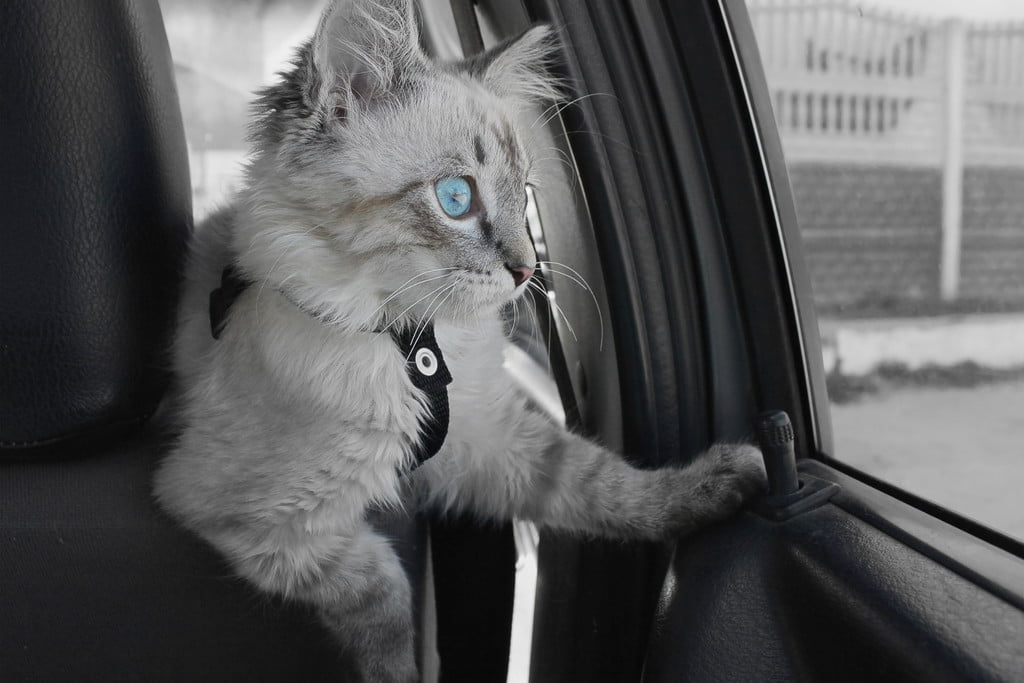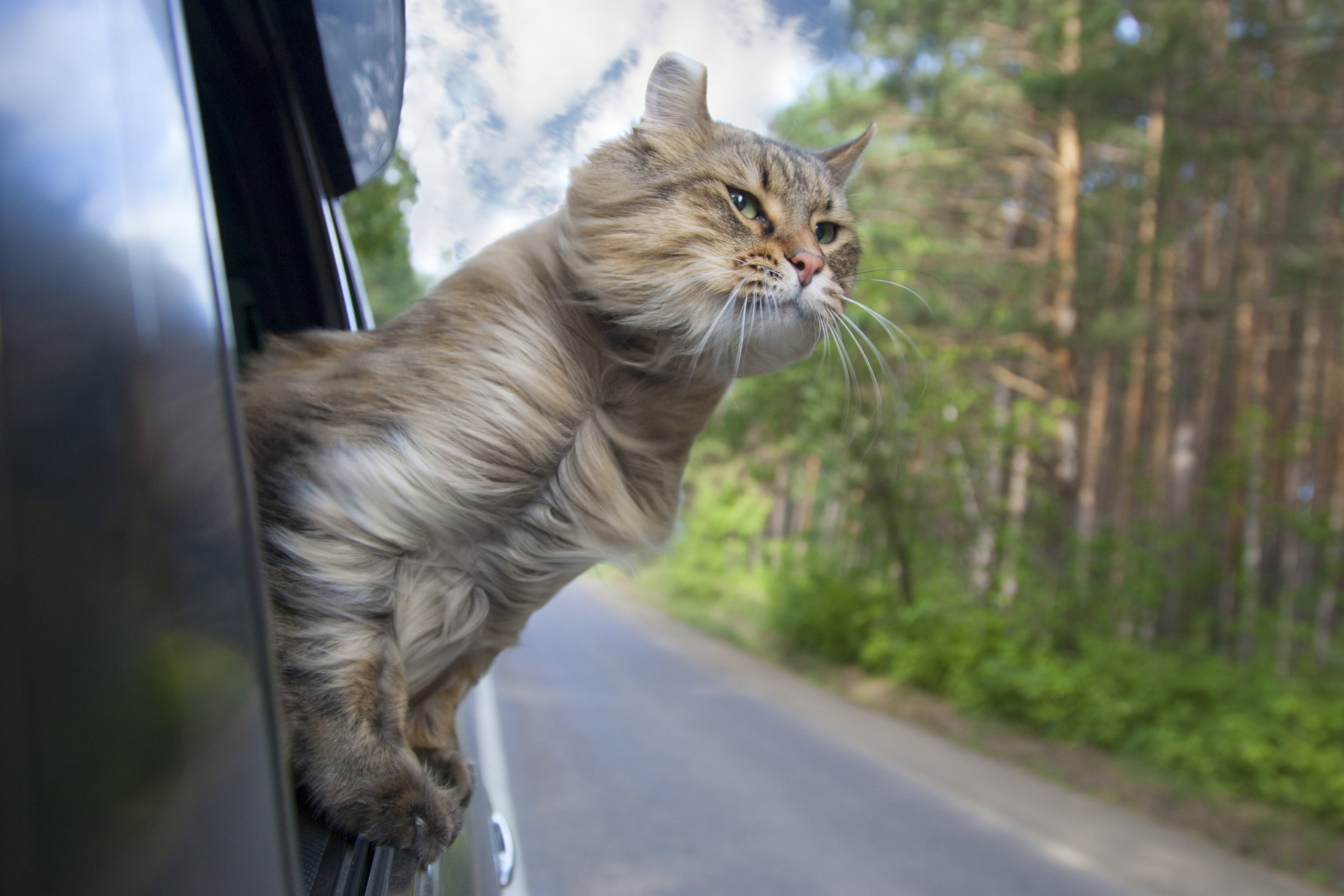Removing Cats From Car Engines: A Step-By-Step Guide

Cats often seek shelter in car engines, especially during the colder months. This can be dangerous for cats, as it may result in extensive burns, injuries, or worse. If you find a cat in your car engine, it is important to take the necessary steps to safely remove it and prevent future incidents. Here are some methods to help you get a cat out of your car engine:
| Characteristics | Values |
|---|---|
| First step | Locate the cat in the engine |
| What to use | A flashlight |
| What to do after locating the cat | Turn off the vehicle |
| What to do after turning off the vehicle | Approach the cat slowly and calmly |
| What to do if the cat doesn’t move | Contact a professional |
| How to prevent cats from entering the engine | Park the vehicle in a garage |
| What to do if parking in a garage is not possible | Use a car cover |
Explore related products
What You’ll Learn
- Prevention tips
- Luring a cat out with food
- Using noise to scare a cat out
- Removing a cat with tools
- Getting professional help
Prevention tips
Cats, especially strays, are attracted to the warmth of car engines. This can be dangerous for them and can also cause damage to your car. Here are some tips to prevent cats from entering your car engine:
Park in a secure location
If possible, park your car in a garage or a secure, enclosed space. This will reduce the likelihood of cats seeking shelter in your engine. Make sure the garage is well-secured and free from any openings or holes that a cat could crawl through.
Keep your car doors and windows closed
Cats can be persistent when looking for a warm place to hide. Keeping your car doors and windows closed will make it more difficult for them to access your engine.
Avoid leaving food or treats in your car
Food and treats will attract cats and other animals to your car. Even if you don’t leave food directly in your engine, the smell may linger and entice cats to investigate.
Install a motion sensor alarm
Consider installing a motion sensor alarm on the outside of your vehicle. This will deter cats from approaching and prevent them from entering the engine bay.
Use deterrents
There are several deterrents you can use to make your engine bay less appealing to cats. For example, you could place a sulphur-filled can in the engine bay. The strong smell will repel cats. Alternatively, you could try using essential oils, vinegar, or citronella. However, these may need to be reapplied more frequently as they will evaporate.
Regularly check your engine
Before starting your car, take a moment to check for any unwanted passengers. Banging on the hood or beeping the horn may be enough to scare away any cats hiding in your engine. You should also check under your vehicle and on top of your tires, as cats may seek shelter in these areas as well.
Can Cats Safely Eat Baby’s Breath Flowers?
You may want to see also
Luring a cat out with food
Luring a cat out of a car engine with food is one of the most effective ways to remove a cat from a confined space. Cats are naturally curious and will often seek out warm and safe spaces, such as car engines, especially during the colder months.
To lure a cat out with food, you can follow these steps:
- Choose the right food: Use food or treats that are highly palatable to cats. This could include their favourite treats or special foods, such as catnip or their favourite wet food. You can also try using their regular kibble if they are food-motivated.
- Place the food: Place the food at a distance from the car, far enough that the cat feels safe but close enough that they can smell it. You don’t want to place it too close to the car, as a scared cat may hide further within the engine.
- Be patient: Cats may take their time to approach the food, especially if they are frightened or unsure. Give them ample time to detect the scent and make their way towards the food.
- Create a trail: If the cat doesn’t come out immediately, you can create a trail of food leading away from the car. Start by placing small amounts of food near the car and gradually increase the distance, creating a path for the cat to follow.
- Use a lure: If the cat is reluctant to leave the engine, try using a lure, such as a toy or a piece of cloth, along with the food. This provides an additional incentive for the cat to leave the confined space.
- Be cautious: Always approach the cat slowly and calmly. Avoid making loud noises or sudden movements that might scare the cat and cause it to retreat further into the engine.
While luring a cat with food can be effective, it may not work on severely frightened or injured cats. If the cat doesn’t respond to the food, you may need to try alternative methods, such as using a lure toy or a blanket to encourage the cat to move out. Remember to always inspect your vehicle before starting the engine to ensure the safety of any curious felines.
The Graceful Grey Tiger-Striped Cat: A Feline Wonder
You may want to see also
Using noise to scare a cat out
If a simple beep doesn’t work, you can try making other loud noises by clapping your hands, banging on the hood, or even using a spray bottle to create a startling sound with water. Noises that mimic the sounds of a mother cat calling her kittens may also be effective. However, be mindful that persistent loud noises may stress the cat further.
Before attempting to scare the cat with noise, it’s crucial to ensure that escape routes are available and that potential hazards, such as nearby traffic, are minimised. If possible, have someone assist you by watching the cat’s movements and blocking off certain exits, so you can guide the cat out safely.
Additionally, combining noise with other methods, such as placing food or treats near the car, can increase the chances of success. Cats are attracted to food, especially if they are hungry, so consider using their favourite treats or foods with strong smells, like tuna or chicken.
The Subtle Clues: How to Determine if a Cat Has an Owner
You may want to see also
How to help cats inside car engines … before it’s too late
Use these tricks to prevent your cat from getting into a car engine
By Vera Lawlor Updated August 27, 2023

Overdrive was only a 2-month-old kitten when he hid inside the engine compartment of a car parked at a rest stop in Arizona. The unsuspecting tourists who owned the car were alarmed when 200 miles later, they stopped at a restaurant in Utah and heard desperate meows coming from under the hood of their car. The tiny buff-colored tabby was successfully rescued and taken to the nearby Best Friends Animal Sanctuary . Although traumatized by the experience, he miraculously didn’t sustain any injuries. He’s just one of numerous cats in car engines that have survived.
Every year, there are stories of cats getting trapped in vehicle engine compartments. Once a car engine starts, things can quickly take a turn for the worse for a cat hiding under the hood, say veterinary experts at the Chastain Veterinary Medical Group in Texas. The sudden vibration and roar of the car’s engine can cause a stowaway cat to jump or fall into the fan or fan belt and pulleys. The results are often disastrous for the cat, causing trauma, lacerations, and on occasion, death.
Recommended Videos
A March 2021 Wigan Today article reported that a cat became stuck in an engine’s camshaft when the car was turned on. Firefighters had to cut the cat from the engine, and he lost his tail and a leg. People magazine recounted the story of Cindy Lou, a 2-year-old Maine Coon who climbed inside the engine compartment of a car in December 2020. She was wedged between two hot metal plates near the fan belts, and part of her fused skin had to be removed to rescue her.

Why do cats hide in car engines?
According to experts at Embrace Pet Insurance, cats and kittens, especially strays, will seek out shelter in colder months and are frequently attracted to the warmth of engines in recently driven cars. When cars are left on streets, driveways, or even easily accessible garages, cats will often sit between the engine and the hood, which provides relief from harsh weather or protection from predators. Animal behaviorists say cats are also attracted to a vehicle’s engine bay because it offers a dark, quiet place to nap.
You would think that if a cat could climb inside the engine compartment of a car, he would also be able to find his way out. However, when frightened or startled, cats may squeeze into even tighter spaces and end up trapped. If you discover a cat in this situation, call the local police or fire department for help. It’s not unusual for a mechanic to be called in to assist in freeing trapped cats from under car hoods.

How can I prevent my cat from climbing into a car engine?
The best way to keep your cat from climbing into a car engine is to prevent him from roaming free. Experts at the Humane Society of the United States say indoor cats live longer and tend to be healthier. In addition, keeping your pet as an inside kitty prevents predators, injuries, parasites, and communicable diseases from the great outdoors. If you live with a cat who’s always asking to go out, access to a patio or a walk around the neighborhood in a harness and leash can give him a safe way to hang outside.
If your cat is allowed out, here are tips to keep him away from your car’s engine:
- Whenever possible, park your car inside an enclosed garage.
- Place a high-quality car cover over your vehicle to help keep your cat from getting to the engine compartment.
- Sprinkle cayenne pepper on the ground around your car. It may take a few days, but cayenne pepper has worked to keep cats away from cars.
- Try a commercial spray such as Nature’s Mace Cat Repellent. Like cayenne pepper, this deterrent can be sprayed around the car to keep cats away.
- Use a motion sensor alarm such as the Tattle Tale Sonic Pet Training Vibration Alarm to discourage your cat from going under the hood of your car.
Keep in mind that while you can take steps to deter your cat from climbing into the engine compartment of your car, he can still hide under the hood of a vehicle in the neighborhood. That’s what happened to Simon, a big orange tabby featured in a KCRA 3 story. He went for a 13-mile ride before the driver realized there was a cat stuck in the engine block. Luckily, Simon wasn’t injured, and thanks to his microchip, was safely reunited with his family.

How do I know if my cat is in my car engine?
It’s simple: check. There are a few ways to remove an unsuspecting kitty from under your hood. Animal advocates at Alley Cat Allies recommend checking under the hood and between the tire and wheel wells. First, take a peek for any obvious signs, but keep in mind that a small kitten might tuck herself away from view. Next, bang on the hood a few times and then hop in and honk the horn. Lastly, consider turning on the car without engaging the engine to start (perhaps with the radio for good measure). That will show even the testiest cat that you mean business.
Overall, you’ll probably have the best luck by implementing preventative measures and then trying to scare off any especially clever cats who make it into the engine, anyway. If you find a repeat offender every morning, you can also put in other deterrents to the general area. Consider speaking to his owner too and coming up with a join solution. The steps here will only take a few minutes and can save a cat’s life.
https://petshun.com/article/how-to-get-a-cat-out-of-a-car-engine
https://www.pawtracks.com/cats/cats-in-car-engines/
